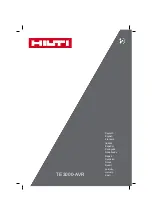
Manual 0-2805
5-3
SERVICE
2. Main Arc Extinguishes
a. Cutting speed too slow
b. Torch standoff too high from workpiece
c. Cutting current too high
d. Work cable disconnected
e. Worn torch parts
f. Non-Genuine Thermal Dynamics parts used
3. Excessive Dross Formation
a. Cutting speed too slow
b. Torch standoff too high from workpiece
c. Worn torch parts
d. Improper cutting current
e. Non-Genuine Thermal Dynamics parts used
4. Short Torch Parts Life
a. Oil or moisture in air source
b. Exceeding system capability (material too thick)
c. Excessive pilot arc time
d. Air flow too low (incorrect pressure)
e. Improperly assembled torch
f. Non-Genuine Thermal Dynamics parts used
5.04 Basic Troubleshooting Guide
WARNING
There are extremely dangerous voltage and power
levels present inside this unit. Do not attempt to
diagnose or repair unless you have had training in
power electronics measurement and troubleshoot-
ing techniques.
A. Basic Troubleshooting: Overview
This guide covers a basic level of troubleshooting that re-
quires limited disassembly and measurements. It is help-
ful for solving many of the common problems that can
arise with this system.
If major complex subassemblies are faulty, the unit must
be returned to an authorized service center for repair.
Follow all instructions as listed and complete each sec-
tion in the order presented.
For major troubleshooting and parts replacement proce-
dures refer to Power Supply Service Manual 0-2806.
B. How to Use This Guide
The following information is a guide to help the Customer
/ Operator determine the most likely causes for various
symptoms. Follow all instructions as listed and complete
each section in the order presented.
This guide is set up in the following manner:
X. Symptom (Bold Type)
Any Special Instructions (Text Type)
1. Cause (Italic Type)
a. Check / Remedy (Text Type)
Locate your symptom, check the causes (easiest listed
first), then remedies. Repair as needed being sure to
verify that unit is fully operational after any repairs.
C. Common Symptoms
A. AC Power indicator OFF
1. Switch at customer's main power panel in OFF position.
a. Close main power panel switch.
2. Customer's main power line fuse(s) blown
a. Check main power panel fuse(s) and replace as
required.
3. Actual input voltage does not correspond to voltage of
unit
a. Verify that the input line voltage is correct. Re-
fer to Appendix 1, Input Wiring Requirements.
4. Unit internal fuse blown or loose
a. If blown, double check input voltage and re-
place fuse per subsection 5.05-B. If fuse blows
again, return unit to an authorized service cen-
ter.
5. Faulty components in unit
a. Return for repair or have qualified technician
repair per Service Manual.
B. AC Power indicator ON; TEMP indicator ON
1. Airflow obstructed
a. Check for obstructed air flow around the unit
and correct condition.
2. Fan blocked
a. Check and correct condition.
Summary of Contents for CE CutMaster 50
Page 10: ...GENERAL INFORMATION 1 6 May 14 2002 ...
Page 22: ...INSTALLATION 3 10 Manual 0 2805 ...
Page 39: ...Manual 0 2805 A 5 APPENDIX Notes ...
Page 40: ...APPENDIX A 6 Manual 0 2805 A 03269 APPENDIX 5 SYSTEM SCHEMATIC FOR 208 230V UNITS ...
Page 41: ...Manual 0 2805 A 7 APPENDIX A 03269 ...
Page 42: ...APPENDIX A 8 Manual 0 2805 APPENDIX 6 SYSTEM SCHEMATIC FOR 400 460V UNITS A 02967 ...
Page 43: ...Manual 0 2805 A 9 APPENDIX A 02967 ...
Page 44: ...APPENDIX A 10 Manual 0 2805 ...
















































